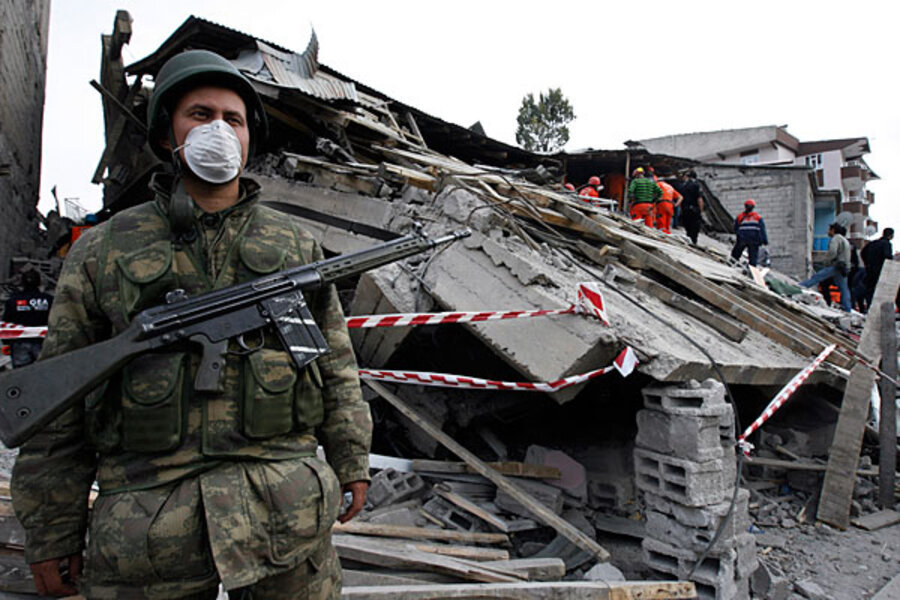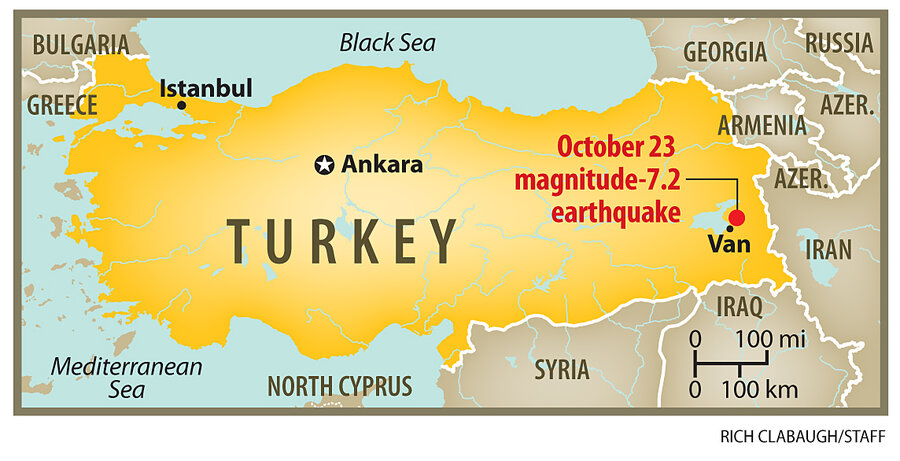Turkey earthquake: Why the country is such a hot spot for seismic activity
Loading...
As rescuers search through rubble hunting for survivors following Sunday's magnitude 7.2 earthquake in eastern Turkey, scientists describe a country whose landscape continues to be sculpted and herded by ever-shifting plates of Earth's crust.
The quake's epicenter was situated some 10 miles east of Lake Van, a salt lake that covers 1,450 square miles. Seismologists estimate that the crust ruptured some 12 miles below the surface.
Authorities say the city of Erciş may have been the hardest hit. Located about nine miles east of the epicenter, the city of some 75,000 people saw 80 multiple-story buildings collapse, according to press reports. The city of Van, on the eastern shore of the lake, also saw many homes and buildings crumble. The death toll throughout the region from the quake stands at 272 so far.
The region is no stranger to strong earthquakes; it sits atop one of the most seismically active spots in the world, researchers say.
In essence, Turkey is a block of crust caught in a geophysical vise between the Arabian plate, which is inching north at a rate of about one inch per year, and the Eurasian plate, which, relatively speaking, represents the immovable object.
"Everything that is happening to Turkey is the result of the Arabian Peninsula smashing its way into Turkey, Iran, and Iraq," explains Russ Stein, a geophysicist with the US Geological Survey in Menlo Park, Calif., who has worked in the region.
The features driving this slow-motion crumpling sit beneath the Red Sea and the Gulf of Aden. Both host mid-sea ridges that run along their lengths. Along the ridges, new crust is welling up and spreading to either side. This spreading gives the Arabian plate its northern push.
The Arabian Peninsula has fellow travelers on either side: the African and Indian plates, which also are migrating north. The trio is responsible for building the arc of mountains that run from the Alps in Europe to the Himalayas.
And like the Indian subcontinent, which is sliding under the Tibetan plateau, the Arabian plate is behaving in a similar manner.
To plate-tectonics aficionados, this might sound like a subduction zone – plate boundaries where denser ocean crust is diving beneath more-buoyant continental crust. In this case, however, Turkey and the Arabian plate are both cut from the same geologic cloth: both consist of crustal rock.
The process presents something of an additional puzzle, particularly in the eastern part of the country, Dr. Stein suggests: Turkey hosts a string of stratovolcanoes, similar to the soaring, snow-capped cones found along the Pacific's "rim of fire." They stretch from east to west along southern Turkey. One of the most storied is Mount Ararat, a dormant volcano on Turkey's eastern border, far from any subduction zone – atypical for this kind of volcano.
Indeed, as he discusses the chain, he looks at a map then acknowledges, "I was just thinking: What the heck are they doing there?"
To complete the picture of a geophysically scrunched country, the Arabian plate's pressure on Turkey also has generated two San Andreas-like faults. Both start from a common point west of Lake Van, then part ways. The Northern Anatolia Fault runs west along the remaining length of northern Turkey and has been responsible for some of the country's most violent quakes. The other, the Eastern Anatolian Fault, heads southeast from the common starting point to terminate at the Mediterranean Sea northeast of Cyprus.
The two faults form the boundaries of a sizable wedge of land that, as it is slowly squeezed, is in effect squirting west into the Aegean Sea toward Greece, Stein explains. He likens it to a wet watermelon seed spurting out from between fingertips – just add pressure.
So far, the fault responsible for Sunday's quake appears to be a blind fault – one that leaves no evidence on the surface for geophysicists to spot.
Stein, who specializes in studying how strain from one quake can trigger quakes on nearby faults, says he is keeping an eye on activity west of Sunday's epicenter. The biggest aftershocks so far have been centered under Lake Van, itself the byproduct of volcanic eruptions from Mount Nemrut, which sits along the lake's western shore.
If Sunday's quake does serve as the trigger for another in the near future, it likely will be to the west, he says.
[ Video is no longer available. ]






